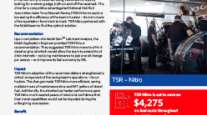Diesel Price Slide Hits Ninth Week as U.S. Average Dips 3.6¢ to $3.851
This story appears in the May 6 print edition of Transport Topics.
The national diesel price average declined another 3.6 cents last week, continuing a two-month slide that has seen the average retail cost of trucking’s main fuel fall 30.8 cents in the past two months.
Diesel, which fell for the ninth straight time last week, was at $3.851 a gallon. The price the previous week was $3.887, and $4.073 at the corresponding time last year, the U.S. Department of Energy said April 29 in its weekly survey of fuel stations.
Gasoline prices also declined for the ninth consecutive week, slipping 1.60 cents a gallon to $3.52, compared with $3.536 a week earlier and $3.83 at this time last year, the DOE said.
While diesel demand has been relatively steady, lower crude oil prices and increased refinery output have ended a price run-up that kept diesel over $4 a gallon for eight weeks this winter, analysts said.
“[Global] crude oil prices have fallen by almost $15, $20 in the last two months,” said Sean Hill, an analyst at the DOE’s Energy Information Administration. “There’s also been a considerable amount of refining capacity back online that was down at the start of the year for maintenance.”
Crude oil settled at $93.99 a barrel on the New York Mercantile Exchange on May 2, down from $97.14 a month earlier and $105.22 a year ago.
Long term, oil production and supply in the United States is breaking records, affecting weekly pump prices, as well as crude oil forecasts, said Phil Flynn, an analyst at Price Futures Group in Chicago.
“There’s a growing belief that we’re turning the corner on these gasoline prices that were up so dramatically over the last 10 years, and the same thing with diesel,” Flynn said.
Recent energy reports appear to underscore Flynn’s outlook.
U.S. oil exports to Canada reached 124,000 barrels a day in February, a level not seen since 2000, the DOE reported April 29.
A day later, on April 30, a new report from the U.S. Geological Survey said the nation has more oil than it thought. The Bakken Formation and the Three Forks Formation, which stretch across North Dakota, South Dakota and Montana, contain an estimated 7.4 billion barrels of recoverable oil, twofold previous estimates, the USGS said.
If the energy industry is experiencing production changes, trucking may be recouping from changes it underwent over the past decade.
Jason Andrus, fuel buyer at Doug Andrus Distributing, the Idaho Falls carrier his grandfather founded, said the carrier has begun recovering fuel performance levels it thought were lost forever.
“We actually right now are at mileages that we were seeing in the late ’90s,” Andrus said. “As they forced the emissions equipment on us, fuel mileage dropped and now we’ve regained it,” he said.
Andrus attributed the mileage gains to more fuel-efficient engines and steps the carrier has taken to reduce consumption.
“We’re constantly experimenting with new equipment and new specs that will get us better fuel mileage,” Andrus said.
He put fairings on trailers and bunk heaters in the cabs to reduce idling, bought aerodynamic tractors and trained drivers to save fuel by telling them to “start slow, stop slow, shift in the right [revolutions per minute] range and don’t idle unnecessarily,” Andrus said.
Two-thirds of the fleet’s 270 trucks are refrigerated, hauling Idaho potatoes and other groceries. That part of the fleet gets an average seven miles to the gallon, Andrus said.
The rest of the fleet is flatbed hauling of building materials, irrigation equipment and hay. Andrus said he has put superwide tires on the flatbeds to help save fuel but that the load configurations make it impossible to estimate an average mileage figure.
Joseph Egan, director of maintenance for Abilene Motor Express, Richmond, Va., said that his fleet also has made equipment changes that save fuel.
Abilene’s 350-unit fleet, for example, has gone to automatic transmissions, which use less fuel than standard transmissions.
“The computer in the truck is actually shifting at the proper points,” Egan said, adding that Abilene is also employing engine settings that adjust horsepower in relation to load.
“You’re not using the horsepower that you don’t need,” he said. Engine horsepower is not at 500 all the time if the truck doesn’t need that much, he added.
Other equipment changes include setting engines to limit idle time. “Our trucks will not idle between 40 and 60 degrees, so, drivers can’t sit in nice weather with the engines idling,” Egan said, adding that the cabs also have diesel-fired heaters to reduce idle time.
“The drivers getting bad fuel mileage or bad idle time, I don’t want to say will be reprimanded, but somebody will bring it to their attention,” Egan said.
Staff reporter Eric Miller contributed to this story.




